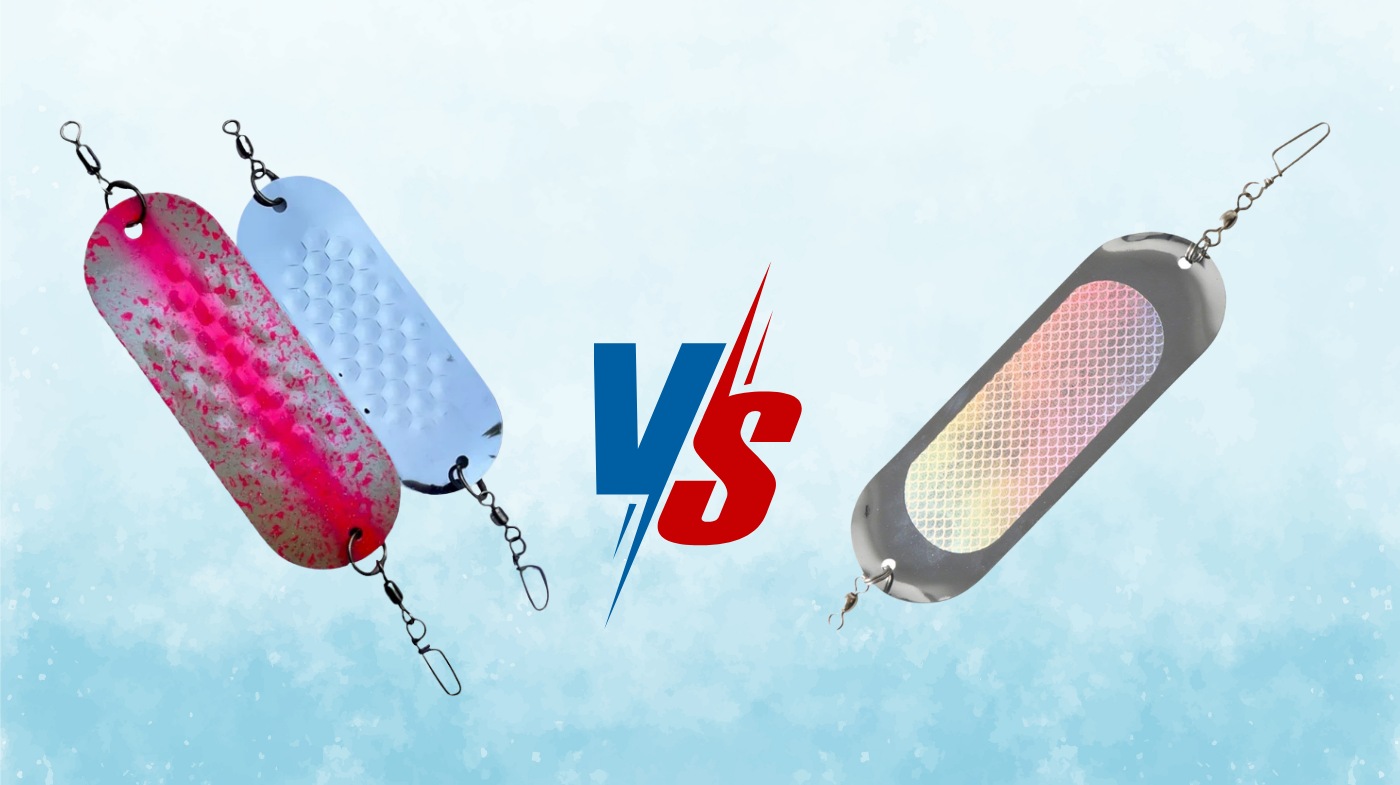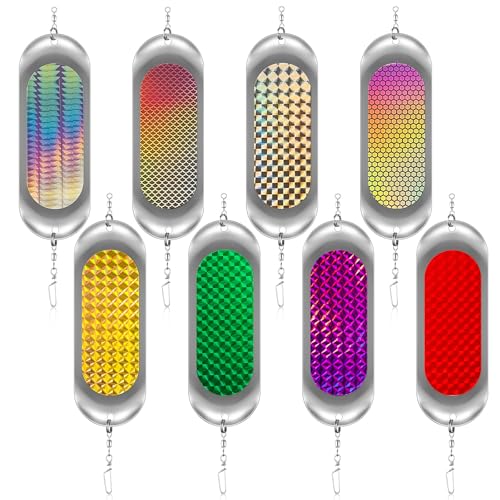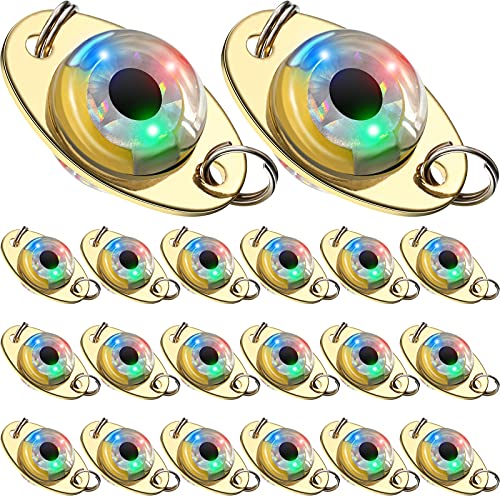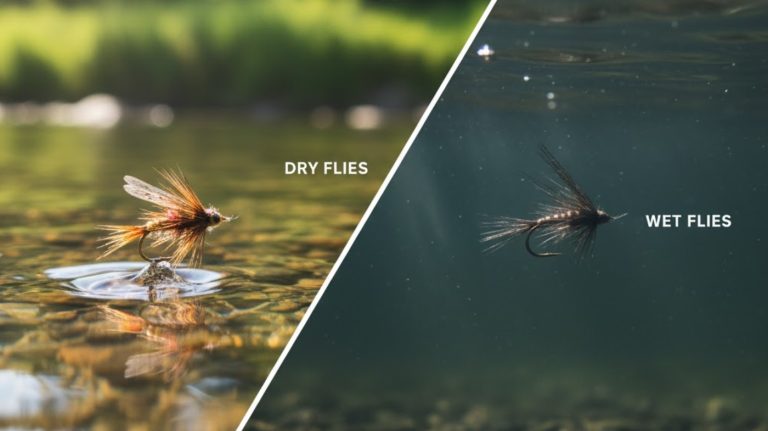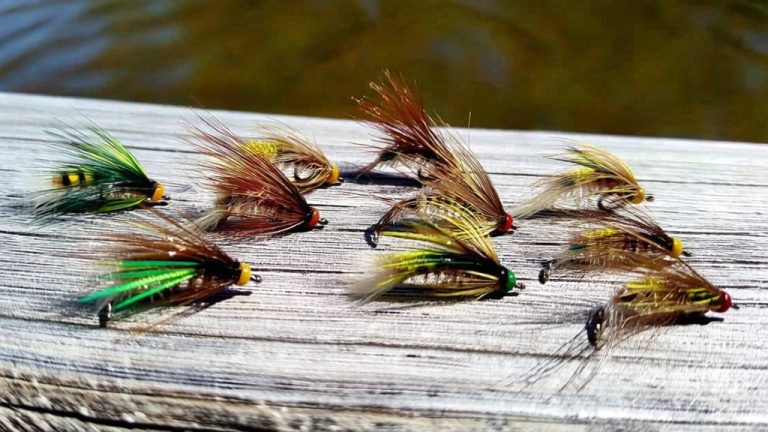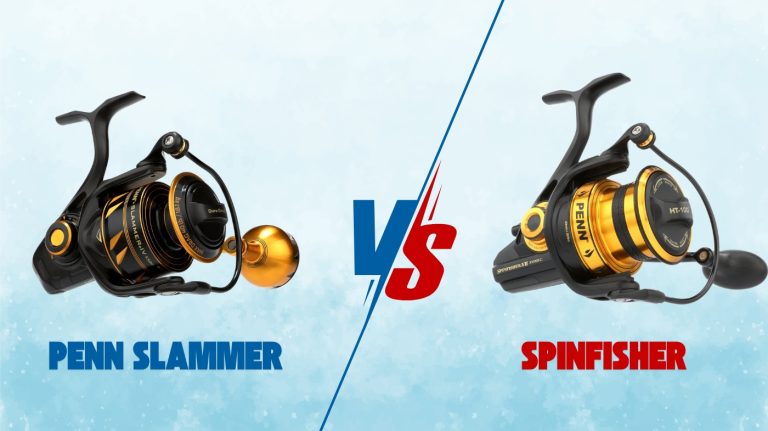Dodger vs Flasher: Key Differences Every Angler Should Know
When choosing between a dodger and a flasher, consider their distinct actions: dodgers sway side-to-side with subtle vibrations, ideal for slow trolling and finesse presentations.
Flashers rotate fully, producing intense flashes and stronger vibrations suited for faster speeds and aggressive fish responses. Dodgers offer tighter hook tension and smaller water resistance, whereas flashers create pulsating drag and broader visibility.
Matching their use to species, depth, and speed matters. Exploring their setups and effects will deepen your fishing strategy.
- Salmon Flasher Length: 4.5 inch, 360 degree rotating churning motion creates interesting irregular…
- Cute and Fun: kokanee dodger wiggles from side to side as it swims, making the movements of spoons,…
- Widely Use: deep water use with spoons, plugs and lures to attract salmon, halibut, lake trout and…
- Package includes: the quantity of deep drop fishing lights is for your choice, they are practical…
- Flashing automatically: the LED light will turn on automatically when it touch water, and turn off…
- Quality material: the shell of the LED fishing lures are made of durable hard ABS plastic, besides,…
Key Takeaways
- Dodgers sway side-to-side with a flat or teardrop shape, creating subtle vibrations best suited for slow trolling around 2.5 MPH.
- Flashers spin fully on a central axis, producing continuous flashes and strong vibrations, optimized for trolling speeds of 3.0–3.5 MPH.
- Dodgers generate finesse and low-speed vibrations mimicking injured baitfish, ideal for clear or shallow water and gentle presentations.
- Flashers create high water resistance and pulsating drag, provoking aggressive fish responses over a broader speed and depth range.
- Dodger setups use short leaders (18–26 inches) for tight, natural action; flashers require longer leaders (18–30 inches) to maximize rotation and flash.
Essential Features Compared for Anglers: Dodger and Flasher
| Feature | Dodger | Flasher |
|---|---|---|
| Primary Movement | Side-to-side sway | Full 360° rotation |
| Visual Attraction | Subtle flash | Strong, continuous flash |
| Vibration Level | Light, rhythmic vibrations | High, pulsing vibrations |
| Optimal Speed | Slow trolling (≈2.5 MPH) | Faster trolling (3.0–3.5+ MPH) |
| Water Resistance | Low, smooth drag | High, pulsating drag |
| Hook Tension | Tight and consistent | More slack during rotation |
| Leader Length | Short (18–26″) | Longer (18–30″) |
| Ideal Conditions | Clear water, finesse presentations | Low-light, deeper, or murky water |
| Fish Response | Triggers cautious or inactive fish | Provokes aggressive strikes |
| Overall Purpose | Natural, subtle action | Maximum flash and visibility |
What sets dodgers and flashers apart in trolling fishing?
Dodgers create a side-to-side swaying motion in the water, while flashers rotate fully (360°) as you troll. Both attach between your main line and lure, enhancing attraction by adding erratic action and extra flash.
Although sometimes used interchangeably, their core difference lies in movement patterns: dodgers pivot to sway, flashers spin completely.
Structurally, dodgers are typically flat or teardrop-shaped plates with a central pivot, smaller and lighter than flashers.
Flashers feature a central axis enabling full rotation, often with reflective surfaces and agitators to boost flash and vibration.
Choosing the appropriate device depends on the targeted fish species and fishing environment, similar to how selecting the correct rig size and design impacts catch success in other fishing techniques like the Jika Rig.
Visual and Vibrational Actions
When you think about the difference between rolling flash from flashers and the side-to-side sway of dodgers, it’s pretty interesting. You’ll notice that they create distinct visual patterns, and these patterns actually influence how fish are attracted differently.
Flashers are all about those intense, continuous flashes and strong vibrations. They really grab attention! Several styles and types are available for lake fishing, each designed to create unique movement patterns. Their effectiveness can depend on factors like water clarity and light conditions, similar to how lens technology impacts fishing visibility.
On the other hand, dodgers offer a steadier, more subtle type of flash along with rhythmic vibrations.
Rolling Flash vs Sway
Although both Rolling Flash and Sway involve coordinated body movements to enhance dance aesthetics, they differ considerably in their visual and vibrational qualities.
When you perform Rolling Flash, you initiate a smooth, continuous rolling of your torso that creates a dynamic, three-dimensional flow. This flowing motion can be likened to the smoothness of operation found in high-quality fishing reels, where fluidity enhances performance. In contrast, Sway leans your body laterally, emphasizing side inclination and wave-like torso motion without necessarily shifting weight.
A key characteristic of Sway is that it involves a phase IV action where the body inclines from the ankle upward away from the unweighted foot, creating a distinctive sideward movement.
Visualize these differences:
- Rolling Flash unrolls your body in a vaulted, flowing rotation enhancing turns and directional changes.
- Sway broadens your line with lateral bends and controlled hip leads, increasing curvature and width.
- Vibrationally, Rolling Flash cycles muscular tension progressively, producing smooth rolling waves, whereas Sway’s vibrational action is subtler, focused on lateral fluidity and extension.
Vibration Patterns Compared
Since vibration patterns directly influence a lure’s effectiveness, understanding the distinct visual and vibrational actions of dodgers and flashers is essential.
Dodgers produce vibrations through interacting waveforms that vary in frequency and amplitude, creating side-to-side swaying that mimics injured baitfish.
Pronounced-wave dodgers excel at slow trolling with quick, powerful vibrations, while weak-wave designs maintain effectiveness at higher speeds. Their finesse-style motion is somewhat comparable to the natural wobbling action seen in spoon lures, which triggers predatory instincts.
Larger dodgers offer stronger flash and vibration for deep water, whereas smaller ones provide subtle signals in clear conditions.
Unlike flashers, dodgers focus vibration within narrow speed ranges and generate finesse-style, light motions that reduce fish disturbance.
This makes dodgers ideal when targeting less active fish needing gentle stimulation. Dodgers are used to maintain attraction at very slow speeds (<1 mph), enabling anglers to fish effectively when the bite slows.
By contrast, flashers deliver broader speed-range vibration and more intense flash, suited for aggressive fish response.
Ideal Trolling Speeds
Understanding the ideal trolling speeds is essential for maximizing the effectiveness of both dodgers and flashers.
Mastering trolling speeds is key to enhancing dodger and flasher performance on the water.
Dodgers perform best around 2.5 MPH, producing a controlled side-to-side sway that attracts fish through finesse. Their design allows for a back-and-forth darting motion that can be bent and controlled for desired action. Maintaining proper speed also helps preserve the structural integrity of fishing gear.
Flashers need faster speeds, typically between 3.0 and 3.5 MPH, to maintain full 360° rotations and peak flashing action.
You can adjust speeds based on fish behavior: increase speed when prospecting or if bites are scarce; decrease it if fish strike but don’t hook, improving lure presentation.
- Dodge at slow speeds (below 1 MPH possible) for subtle, controlled action.
- Flasher rotation requires minimum speeds above 1 MPH, ideally 3.0 to 3.5 MPH.
- Modify trolling speed dynamically to match fish mood and strike response.
Water Resistance and Hook Tension
When you troll with flashers and dodgers, you’ll notice they create very different water resistance and affect hook tension in distinct ways. Flashers generate strong 360-degree rotational resistance, causing more drag and vibration, which can lead to slack when breaking the water surface. This rotational movement is most effective at speeds between 3-5 mph, where the flasher’s resistance and flash can attract more fish.
Dodgers sway side-to-side, producing less resistance and helping maintain tighter, more consistent hook tension, especially at slower speeds. Their smoother action also helps reduce wear on the line, contributing to better abrasion resistance.
| Aspect | Flasher | Dodger |
|---|---|---|
| Water Resistance | High, pulsating 360-degree drag | Low, smooth side-to-side sway |
| Hook Tension | Slack on surface breakout | Consistent, tight tension |
| Speed Sensitivity | Best at 3-5 mph, more resistance | Performs well under 3 mph |
| Vibration | Noticeable, can risk line breaks | Minimal, easier tension control |
Adjusting Presentation and Lure Action
Water resistance and hook tension influence how you adjust presentation and lure action with flashers and dodgers. With dodgers, you bend the arm to fine-tune wobble and vibration. This is ideal for subtle presentations at slow speeds, especially when line control is crucial.
Flashers rely more on blade size and style, producing broad, flashy action that covers more water. They work well across varied speeds. Choosing the right flasher color based on depth and weather can significantly increase fishing success.
To optimize your presentation:
- Bend the dodger arm for precise wobble changes, matching fish activity levels.
- Swap flasher blades or agitators to alter flash intensity and vibration.
- Adjust trolling speed: slow down with dodgers for inactive fish or maintain speed with flashers for aggressive bites.
Effective Color and Size Choices
Although choosing the right color and size for your dodgers and flashers depends heavily on environmental conditions, these factors directly influence your lure’s visibility and appeal to fish.
Bright colors like chartreuse and red boost visibility in murky water, while natural hues such as silver and blue mimic baitfish in clear water.
Contrasting colors enhance visual signals, stimulating strikes.
Size affects vibration and flash; larger dodgers attract fish from farther away, making them ideal for deep water.
Smaller flashers suit shallow or clear conditions to avoid spooking fish.
Matching size to lure and trolling speed ensures a natural presentation.
Metallic finishes increase flash intensity in darker environments.
Both dodgers and flashers require consideration of movement type to maximize their attractiveness to fish.
Depth and Light Condition Considerations
Selecting the right dodger or flasher color and size sets the foundation, but understanding how depth and light conditions affect visibility can greatly enhance your lure’s effectiveness.
Blue-green light penetrates deepest, making blue or green dodgers suitable for deeper water. Red and orange hues fade quickly near the surface, limiting their use to shallow depths. Additionally, underwater LED lights can simulate natural light cycles, improving lure visibility in various conditions. Choosing the correct lens technology can similarly optimize visual performance in fishing environments.
Blue and green dodgers excel in deep water, while red and orange work best near the surface.
White LEDs vary with water clarity, so consider turbidity when choosing flasher brightness.
Focus on these factors:
- Depth: Use blue-rich colors below 20 meters to maximize visibility.
- Water Clarity: Clear water allows deeper light penetration; turbid water demands brighter, contrasting flashes.
- Ambient Light: Adjust for natural light levels; low light favors more reflective or luminous flashers.
Leader Setup and System Configuration
When you’re setting up your leader, it’s really important to think about the length and stiffness. This can make a big difference depending on the fishing conditions and the type of species you’re after. You want to make sure everything is just right! Upcycling old fishing gear, like waders, can help you create customized leader setups tailored to your specific needs.
Now, let’s talk about weight placement and spacing. Getting this right is crucial because it ensures that your dodger or flasher can keep that natural action and depth you want. Trust me, it makes a world of difference!
And don’t forget about how you attach everything! Using secure techniques like snap swivels or tied knots is key. This will help you avoid line twist and keep your system reliable. You definitely don’t want any surprises while you’re out there fishing! Additionally, it’s important to inspect and maintain your equipment regularly to ensure it performs optimally and lasts longer.
Leader Length and Stiffness
Since leader length and stiffness directly influence your lure presentation and casting control, you need to tailor these factors carefully to your fishing method and conditions. The tippet length and diameter play a crucial role in achieving the desired presentation and matching fly size for better results.
For example, fly fishing leaders vary from 6 to 12 feet, with shorter leaders enhancing casting control for streamers and heavier flies. Longer leaders improve presentations in clear water. Stiffness also matters; butt sections use stiffer monofilament for strength, while mid-sections are more flexible for subtle movements.
Consider these three key points:
- Short leaders (6–7.5 ft) provide better casting control in turbulent water or with heavy flies.
- Longer leaders (9–12 ft) aid delicate presentations in calm, clear water.
- Fluorocarbon leaders offer stiffness and low visibility, ideal for stealthy approaches.
In trolling setups, the leader length should be matched to the type of lure to ensure the lure’s natural movement is not dampened by excessive stiffness or length. Additionally, using a tippet ring can facilitate quick changes without compromising the leader’s performance.
Adjust leader length and stiffness based on your targeted species and environment for effective lure action.
Weight Placement and Spacing
Although weight placement may seem straightforward, it critically influences the dodger’s action and overall system performance. Choosing the right weight type, like keel-type sinkers for up to six ounces or round lead balls with Abe ‘n Al® swivels beyond that, ensures ideal action transfer and minimal line twist. Additionally, the trolling speed must be fast enough to maintain the dodger’s side-to-side motion, as action results from a combination of weight and speed.
Proper spacing between the weight and dodger is essential. Too short a leader restricts the dodger’s side-to-side sway, reducing fish attraction.
| Weight Type | Max Weight (oz) | Effect on Action |
|---|---|---|
| Keel-type sinker | 6 | Adequate for light rigs |
| Round lead ball | >6 | Maximizes action transfer |
| Abe ‘n Al® swivel | >6 | Minimizes tangles |
| Short leader | N/A | Restricts dodger motion |
| Optimal spacing | N/A | Allows full dodger sway |
You must balance weight and spacing to maintain effective lure action.
Attachment Techniques and Tips
Because proper attachment techniques directly influence dodger and flasher performance, you must carefully configure leader setups and system connections.
For dodgers, attach the mainline to specific holes to control swing angle. Keep leader lengths short (18–26 inches) for proper action, and use swivels to reduce line twist. Using a 60/40 band on dodgers helps control action and speed for optimal fish attraction.
Flashers require longer leaders behind them (18–30 inches) to maximize lure movement. They should be rigged with the narrow end forward for effective rotation.
Key points to focus on:
- Adjust dodger attachment holes to modify lateral swing and offset from the boat.
- Maintain leader distance behind weights to prevent tangling and preserve natural action.
- Use swivels and three-way connectors to minimize line twists and enhance lure presentation.
Target Species Preferences
When targeting specific species, understanding their depth, temperature, and action preferences can profoundly enhance your success with dodgers and flashers.
Coho salmon prefer shallow waters under 50 feet and respond best to rapid, side-to-side dodger action with short leaders. Smaller dodgers are generally more effective in these early season and shallow water conditions, as they produce the ideal vibration and sound.
Chinook salmon inhabit deeper waters and favor slow, subtle flashers with longer leaders to mimic natural prey.
Lake trout thrive in deep, oxygen-rich zones, requiring slow trolling and longer leaders to reduce lure aggression.
Kokanee occupy pelagic zones near the surface in cooler temperatures, demanding short leaders and high-action dodgers.
Saltwater species like lingcod and halibut vary with depth and current; you’ll adjust leader strength and length accordingly.
Matching lure size and action to species behavior and habitat is key to optimizing your fishing strategy.
Combining Flashers and Dodgers for Versatility
Combining flashers and dodgers in a single rig enhances your ability to attract fish by leveraging the distinct actions of both devices.
By rigging the flasher ahead of the dodger with precise leader lengths—4 to 5 feet between flasher and dodger, and 20 to 24 inches from dodger to lure—you create a versatile, multi-dimensional presentation. Flashers produce a tail kick and vibration that mimics real baitfish, adding an extra sensory cue to attract salmon.
This setup maximizes flash and vibration from the flasher while the dodger mimics erratic baitfish movement, increasing visibility and appeal.
Consider these key points:
- The flasher’s 360-degree rotation draws fish from a distance.
- The dodger’s side-to-side motion triggers strikes.
- Proper trolling speed (1.5–2.5 mph) ensures both actions work effectively.
This combination suits diverse species and conditions, adapting easily by changing sizes, colors, or lure types.
Frequently Asked Questions
Can Flashers or Dodgers Be Used Effectively in Saltwater Environments?
You can absolutely use flashers or dodgers effectively in saltwater. They’re like underwater lighthouses for fish.
Flashers create dazzling 360° rotations and strong vibrations, ideal for faster trolling and murkier waters.
Dodgers sway side-to-side, mimicking wounded baitfish, perfect when fish are cautious or slower.
Adjust your trolling speed and size based on conditions, and switch between them to match fish behavior for the best results in saltwater fishing.
What Maintenance Tips Extend the Lifespan of Flashers and Dodgers?
To extend your flashers and dodgers’ lifespan, rinse them with fresh water after each use to remove salt and debris.
Inspect for damage or wear regularly and lubricate moving parts to prevent rust.
Store them in a cool, dry place away from direct sunlight, ensuring they’re completely dry beforehand.
Sharpen or replace dull hooks, and avoid abrupt trolling starts to reduce stress on components.
Following these steps keeps your gear reliable and effective.
Are There Specific Brands Known for High-Quality Flashers or Dodgers?
Think of top fishing gear brands as lighthouses guiding you through a stormy sea. You’ll want to check out Luhr-Jensen and Brad’s Killer Fishing Gear for high-quality flashers and dodgers that create strong vibrations to attract fish.
Vance’s Tackle Company specializes in kokanee fishing dodgers with extended lengths for better performance. Dreamweaver and Character Lures also offer reliable options.
These brands combine durability and innovation, ensuring your fishing tackle stands the test of time.
How Do Weather Changes Impact the Choice Between Dodger and Flasher?
You’ll want to adjust your choice based on weather because light and water conditions shift fish behavior.
On sunny days, dodgers with bright, reflective colors work well, while overcast or low-light conditions favor flashers with glow or white finishes for better visibility.
Wind and waves affect thermocline depth, so you might switch to larger flashers for deeper trolling or dodgers for subtle action during slower bites.
Adapt daily for best results.
Can Flashers or Dodgers Be Customized With Additional Attractors or Scents?
Imagine you add feathers and scent capsules to your dodger, boosting its realism and olfactory appeal underwater.
Yes, you can customize both flashers and dodgers, but methods differ.
Flashers mainly get visual tweaks like unique colors or shapes to heighten attraction, while dodgers often receive mechanical additions and scent applications.
Keep in mind, over-customizing might hinder their action, so balance is key for effective fish attraction.
Turn This Dodger vs Flasher Comparison Into Better Trolling Results
Choosing between a dodger and a flasher is like picking the right tool from a tackle box. Each has a distinct role that enhances your fishing strategy.
Dodgers offer tight, darting action ideal for clear water and precise targeting. Flashers provide broader flashes and vibrations to attract fish in murkier conditions.
Understanding their differences lets you adjust presentation and leader setup effectively, maximizing your chances regardless of species or environment. Use them wisely to master your trolling game.
- Perfect for Trolling Flashers & Salmon Fishing: The ELEHUA 4.7-inch flasher features a 360-degree…
- Lifelike Action for Enhanced Attraction: This Kokanee Dodger wiggles side-to-side, adding realistic…
- Versatile Fishing Applications: Designed for trolling flashers and dodgers, these flashers work with…
- 【High-Quality Metal Construction】 – These trolling lures dodgers flashers are made of durable…
- 【Enhanced Night Fishing Performance】 – Designed with glow-in-the-dark technology, these fishing…
- 【Optimal Size & Reflective Flash】 – Measuring 1.57 x 4.65 inches, these salmon lures create…
Last update on 2025-11-25 / Affiliate links / Images from Amazon Product Advertising API

